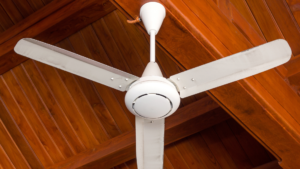
Though fans require only a small amount of power, they have a huge effect on your energy costs, allowing you to stay comfortable indoors even at higher temperatures.
Ceiling Fans Save Money
Ceiling fans consume about one cent of electricity every hour. Air conditioners, on the other hand, consume about 36 cents. Despite this, ceiling fans aren’t a substitute for air conditioners, at least not in most climates. Instead, they enhance your cooling system, so you can run your air conditioner at a higher setting without sacrificing comfort.
Air conditioners are one of the most expensive appliances in your home. During summer, they’re responsible for about a quarter of your energy costs. As a result, raising your thermostat even a few degrees has huge, long-term benefits. Every degree raises or lowers your electricity consumption by roughly one percent.
Running a ceiling fan lets you set your thermostat as much as four or five degrees higher, which leads to considerable savings over the course of a summer. It also provides an alternate way to stay cool in the early morning and late afternoon, so you only need to rely on your air conditioner during the hottest part of the day. The longer you can wait before switching it on, the less you spend and the more you save.
Saving Energy with Ceiling Fans
Ceiling fans don’t cost much to own or operate. However, to get the most out of them, there are a few tips you’ll need to follow.
- Don’t Install Fans in Rooms You Don’t Use. Look for areas where people congregate, such as kitchens, bedrooms, dining rooms, and living rooms. Some homeowners even install them outside over their patio.
- Switch Fans Off. Fans cool people so there’s no sense circulating air in an empty room. Unless you plan on returning soon, always switch the fan off when you leave.
- Never Place a Fan More Than 10 Feet High. Fans are effective in rooms with high ceilings, but only if they’re positioned correctly. They work best when they’re 7-9 feet above the floor and at least 10-12 inches below the ceiling.
- Choose the Right Size. A fan that’s too big will overpower the room, while one that’s too small won’t be able to cool you down. Small rooms (64 square feet) require a 30-inch fan. Mid-size rooms (81-144 square feet) require a 40-50 inch fan. Large rooms (144-256 square feet) require a 50-60 inch fan. Rooms over 256 square feet require multiple fans ‒ one every 18 feet.
- Reverse Flow in Winter. Ceiling fans can save money in winter as well as summer. Reversing their spin prevents hot air from accumulating around the ceiling, so you don’t have to set the thermostat as high to stay warm.